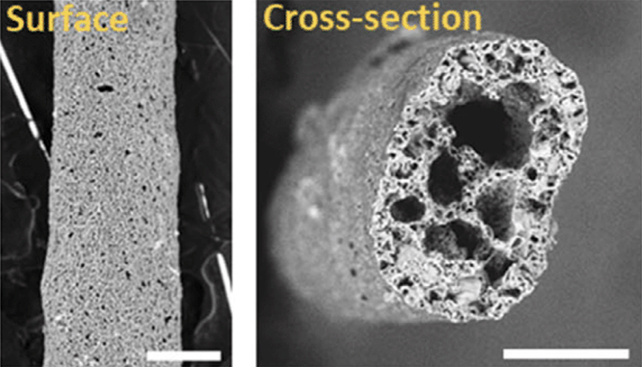Slicing up and analyzing real, living, three-dimensional brain tissue comes with some obvious complications – as in, it tends to be needed by its owner. But scientists are now closer than ever to being able to grow realistic brain tissue models in the lab to experiment on instead.
A team of researchers led by the University of California, Riverside (UCR) have created a tiny scaffolding some 2 millimeters (0.08 inches) wide, on which donated neural stem cells can be attached and develop into full neurons.
The scaffolding is called BIPORES – or the Bijel-Integrated PORous Engineered System – and it's made mostly of the common polymer polyethylene glycol (PEG). The researchers modified the PEG to make it 'sticky' for brain cells, without needing the usual coatings that can interfere with the reliability of the science.
Related: Our Brains Evolved Powerful Mechanisms To Protect Our Weight
The researchers added silica nanoparticles and changed the shape of the PEG in such a way that it created a matrix of microscopic sponge-like pores for the cells to cling to. The structure is also curved and stabilized in such a way that natural cell growth and expansion are encouraged.
"The material ensures cells get what they need to grow, organize, and communicate with each other in brain-like clusters," says Iman Noshadi, bioengineer at UCR.
"Because the structure more closely mimics biology, we can start to design tissue models with much finer control over how cells behave."

The new scaffolding addresses several problems with existing methods for growing brain tissue in the lab. The researchers say it promises to produce tissue that's more human-like, more stable, and as such can grow more mature than current approaches, without using any chemicals or materials derived from other animals.
"Since the engineered scaffold is stable, it permits longer-term studies," says bioengineer Prince David Okoro, from UCR.
"That's especially important as mature brain cells are more reflective of real tissue function when investigating relevant diseases or traumas."
Even better, because the neural stem cells that grow upon the scaffold can be adapted from human blood or skin cells, researchers could potentially create 'test neurons' that are personalized to particular patients.
When it comes to researching neurodegenerative diseases and other brain injuries – including strokes – that personalization could be crucial to making new discoveries, according to the study authors.
Being able to test brain tissue in the lab that's very close to the real thing would mean a reduced dependency on animal brain testing. Not only is that better from an ethical point of view, it also means subsequent findings are more likely to apply to people, and not just the animals being used as substitutes.
There are still plenty of challenges to overcome to get this working properly – including scaling it up beyond its current small size – but it's a very promising improvement. The researchers are also confident that their approach here could apply to other organs in the body, such as the liver.
"An interconnected system would let us see how different tissues respond to the same treatment and how a problem in one organ may influence another," says Noshadi.
"It is a step toward understanding human biology and disease in a more integrated way."
The research has been published in Advanced Functional Materials.

